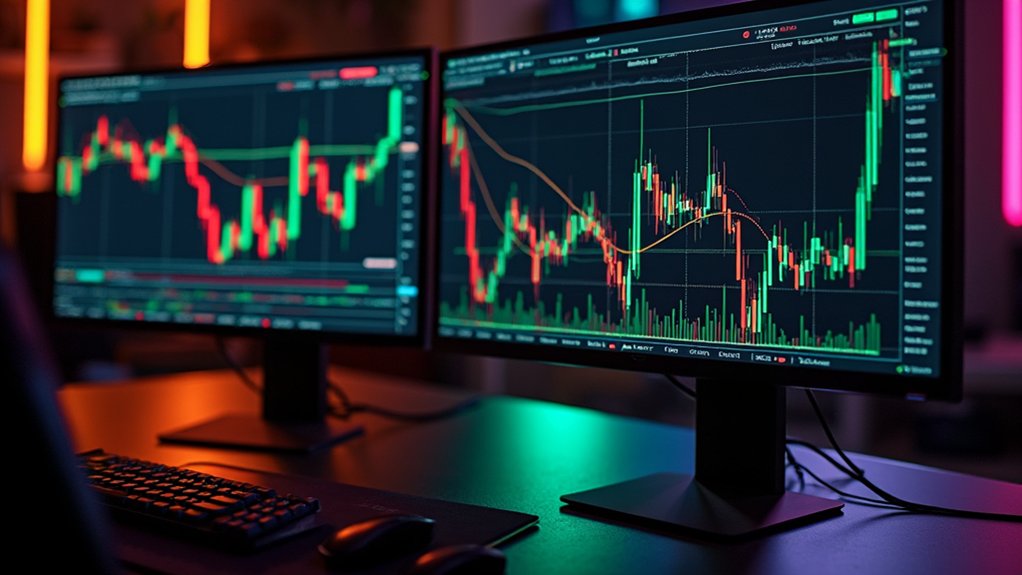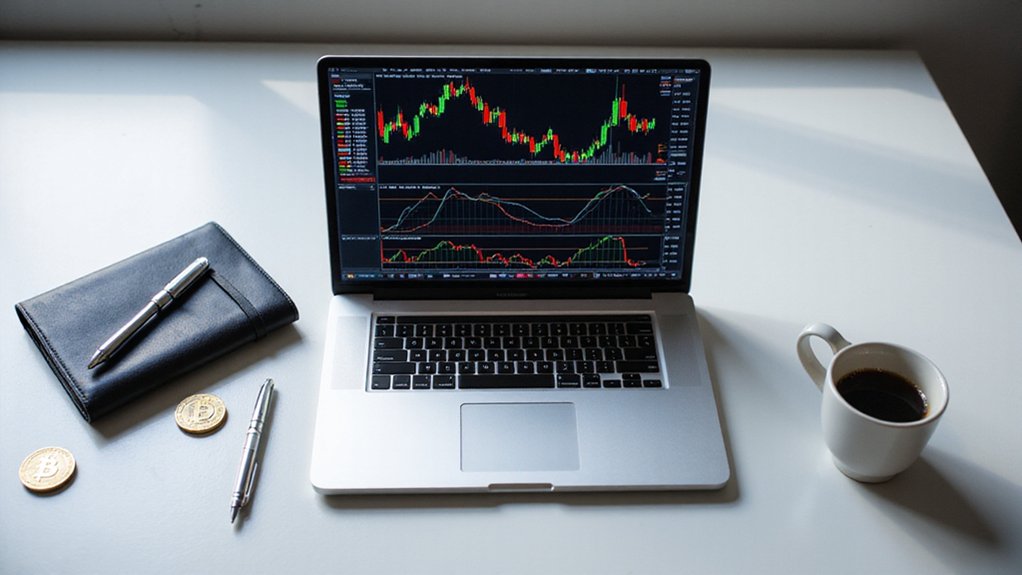TradingView elevates cryptocurrency analysis beyond basic exchange charts through sophisticated technical indicators, multi-timeframe analysis, and customizable drawing tools that reveal market patterns invisible to casual observers. Traders access advanced features like RSI, MACD, and Bollinger Bands while linking accounts to supported brokers for seamless order execution—though trading permissions require patience (up to 24 hours for approval, naturally). The platform’s depth-of-market tools expose liquidity patterns that separate profitable positions from expensive educational experiences, with extensive strategies awaiting those who venture further into its analytical depths.

Maneuvering the labyrinthine world of cryptocurrency trading requires sophisticated tools, and TradingView has emerged as the platform of choice for traders who demand more than the rudimentary charting capabilities offered by most exchanges. The platform’s extensive cryptocurrency database enables users to analyze virtually any digital asset worth trading (and, admittedly, countless ones that aren’t), while its customizable interface transforms raw market data into actionable intelligence through technical indicators, drawing tools, and multi-timeframe analysis.
Account setup presents traders with the eternal choice between free and paid tiers—though serious cryptocurrency analysis typically demands features locked behind subscription paywalls. Once established, users can apply sophisticated indicators including Moving Averages, RSI, MACD, and Bollinger Bands, creating analytical frameworks that would make traditional equity traders envious. The platform’s drawing tools facilitate precise support and resistance mapping, trend channel identification, and Fibonacci retracements specifically calibrated for cryptocurrency market dynamics.
Live trading execution requires linking TradingView to supported brokers, enabling seamless order placement directly from charts. Market orders provide immediate execution at prevailing prices, while limit orders activate when predetermined conditions materialize—assuming the notoriously volatile crypto markets cooperate with such orderly expectations. The platform’s depth of market tools reveal liquidity patterns and volume flows that sophisticated traders leverage for timing optimization. Before executing trades, traders must ensure proper trading permissions are obtained through their broker’s client portal, which may require up to 24 hours for approval.
Advanced practitioners increasingly integrate specialized indicators like Token Metrics, which delivers AI-driven signals and sentiment analysis through proprietary analytics (available to those willing to navigate invite-only subscription tiers). These tools promise enhanced entry and exit point identification, though whether artificial intelligence can truly decode cryptocurrency market irrationality remains debatable. Many sophisticated traders now incorporate crypto options analysis to hedge against adverse price movements while maintaining position exposure. For comprehensive portfolio oversight, traders often complement TradingView’s charting with dedicated portfolio trackers that monitor holdings across multiple exchanges and wallets simultaneously.
Strategic implementation spans multiple approaches: HODLing strategies benefit from long-term trend analysis, while swing traders exploit technical setups identified through TradingView’s indicator arsenal. Risk management becomes paramount through customizable price alerts, stop-loss positioning based on chart-identified support zones, and risk-reward ratio calculations.
The platform’s multi-chart layouts enable correlation analysis between cryptocurrency pairs, facilitating arbitrage opportunities and sophisticated pair trading strategies that capitalize on market inefficiencies across the digital asset ecosystem.
Frequently Asked Questions
Can Tradingview Execute Trades Directly or Only Provide Analysis Tools?
TradingView has evolved beyond its original analysis-only model through strategic broker integrations.
While the platform cannot execute trades independently, recent partnerships with HTX and Coinbase Advanced enable direct cryptocurrency trading within TradingView‘s interface.
Users connect their broker credentials to place orders seamlessly from the charting platform—a hybrid approach that transforms TradingView from purely analytical tool into extensive trading ecosystem, though execution still occurs through third-party infrastructure.
What Are the Main Differences Between Tradingview’s Free and Paid Plans?
TradingView’s free plan offers basic charting with one chart per tab, three indicators, and a single alert—hardly generous for serious analysis.
Paid tiers progressively enable multiple charts (up to eight), expanded indicators (twenty-five maximum), hundreds of alerts, and ad-free browsing.
Premium subscribers enjoy priority support, advanced technical tools, extended historical data, and faster refresh rates.
The pricing structure ($13.99 to $56.49 monthly) clearly targets different trader sophistication levels, from casual observers to institutional professionals.
How Do I Connect My Cryptocurrency Exchange Account to Tradingview?
Users navigate to TradingView’s Trading Panel and select their preferred exchange—Binance, Coinbase Advanced, or Bybit among others.
After clicking “Connect,” they authorize TradingView’s access to portfolio data and trading permissions. The exchange account must be adequately funded with trading permissions enabled.
Some integrations facilitate direct trade execution from charts, while others merely provide portfolio viewing—a distinction that presumably matters to those actually planning to trade rather than merely spectate.
Can I Set up Automated Trading Alerts for Specific Price Movements?
TradingView offers robust automated alert functionality for specific price movements through multiple setup methods—toolbar buttons, hotkeys (ALT+A), or right-click menus.
Users can configure alerts based on data series, indicators, or custom conditions with precise trigger parameters. These alerts integrate seamlessly with trading bots via webhook URLs, enabling fully automated execution upon price triggers.
Customizable frequency settings, expiration dates, and message placeholders guarantee alerts remain relevant and actionable for cryptocurrency trading strategies.
Does Tradingview Support All Major Cryptocurrencies and Trading Pairs?
TradingView supports virtually all major cryptocurrencies and trading pairs, from Bitcoin and Ethereum to obscure altcoins and exotic cross-pairs.
The platform aggregates data from multiple exchanges, offering thorough coverage of fiat pairs, crypto-to-crypto combinations, and stablecoin pairings.
While some extremely new or illiquid tokens might experience brief delays in listing, TradingView’s extensive database captures the vast majority of tradeable pairs across the cryptocurrency ecosystem.









